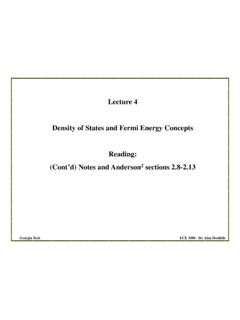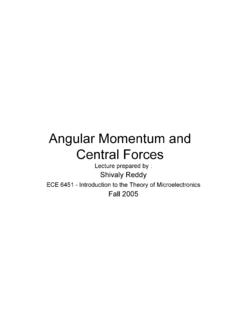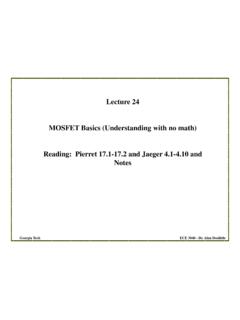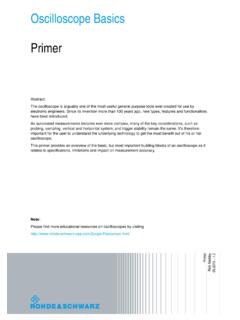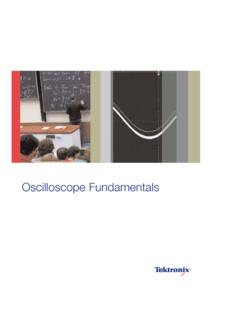Transcription of Density of States
1 ECE 6451 Georgia Institute of TechnologyLecture Prepared by: Calvin R. King, Institute of TechnologyECE 6451 Introduction to Microelectronics TheoryDecember 17, 2005 Density of States :2D, 1D, and 0 DECE 6451 Georgia Institute of TechnologyIntroductionThe Density of States function describes the number of States that are available in a system and is essential for determining the carrier concentrations and energy distributions of carriers within a semiconductor. In semiconductors, the free motion of carriers is limited to two, one, and zero spatial dimensions.
2 When applying semiconductor statistics to systems of these dimensions, the Density of States in quantum wells (2D), quantum wires (1D), and quantum dots (0D) must be known. ECE 6451 Georgia Institute of TechnologyDerivation of Density of States (2D)We can model a semiconductor as an infinite quantum well (2D) with sides of length L. Electrons of mass m* are confined in the we set the PE in the well to zero, solving the Schr dinger equation yields(Eq. 1)022222222=+ + = kyxEmh22hmEkwhere=ECE 6451 Georgia Institute of TechnologyDerivation of Density of States (2D)Using separation of variables, the wave function becomes(Eq.)
3 2)Substituting Eq. 2 into Eq. 1 and dividing through by yieldswhere k= constantThis makes the equation valid for all possible x and y terms only if terms includingare individually equal to a constant. )()(),(yxyxyx =01122222=+ + kyxyx yx )()(yandxyx ECE 6451 Georgia Institute of TechnologyDerivation of Density of States (2D)Thus, whereThe solutions to the wave equation where V(x) = 0 are sine and cosine functionsSince the wave function equals zero at the infinite barriers of the well, only thesine function is valid. Thus, only the following values are possible for the wave number (k): 22222211kykxyx = = 222yxkkk+=)cos()sin(xkBxkAxx+=.
4 3,2,1, ===nforLnkLnkyyxx ECE 6451 Georgia Institute of TechnologyDerivation of Density of States (2D)Recalling from the Density of States 3D volume of single state cube in k-space: k-space volume of sphere in k-space: V is the volume of the crystal. Vsingle-stateis the smallest unit in k-spaceand is required to hold a single = = = VcbaVstategle3sin 22hmEkwhere=ECE 6451 Georgia Institute of TechnologyDerivation of Density of States (2D)Recalling from the Density of States 3D volume of single state cube in k-space: = = = 333sinLVcbaVstategle k-space volume of sphere in k-space: 343kVsphere =Number of filled States in a sphere.
5 = 2121212sinstategleSphereVVN2333333481234 LkLkN= =A factor of two is added to account for the two possible electron spins of each factor for redundancy in counting identical States +/- nx, +/-ny, +/- nzECE 6451 Georgia Institute of TechnologyDerivation of Density of States (2D)For calculating the Density of States for a 2D structure ( quantum well), we can use a similar approach, the previous equations change to the following:k-space volume of single state cube in k-space: k-space volume of sphere in k-space: = = = 222sinLVbaVstategle 2kVcircle = 24122121222222sinLkLkNVVN stateglecircle= = = Number of filled States in a sphere:ECE 6451 Georgia Institute of TechnologyDerivation of Density of States (2D) ,222 LkN=The Density per unit energy is then obtained using the chain rule: Substituting yields 2222222hhEmLLmEN= =22h mLdEdkdkdNdEdN==ECE 6451 Georgia Institute of TechnologyDerivation of Density of States (2D)The Density of States per unit volume, per unit energy is found by dividing by V (volume of the crystal).
6 G(E)2 Dbecomes:As stated initially for the electron mass, m m*. Thus, 22222)(hh mLmLEgD==2*2)(h mEgD=It is significant that the 2D Density of States does not depend on energy. Immediately, as the top of the energy-gap is reached, there is a significant number of available 6451 Georgia Institute of TechnologyDerivation of Density of States (1D)For calculating the Density of States for a 1D structure ( quantum wire), we can use a similar approach. The previous equations change to the following:k-space volume of single state cube in k-space: k-space volume of sphere in k-space: = = = LVaVstategle sinkVline= kLLkNVVN stategleline== = 212sinNumber of filled States in a sphere:ECE 6451 Georgia Institute of TechnologyDerivation of Density of States (1D) , kLN=The Density per unit energy is then obtained by using the chain rule.
7 Substituting yields hhLmELmEN222==()() hhmLmEmLmEdEdkdkdNdEdN = == 2/12/122221() hLmEN2/12=ECE 6451 Georgia Institute of TechnologyDerivation of Density of States (1D)The Density of States per unit volume, per unit energy is found by dividing by V (volume of the crystal).g(E)1 Dbecomes:Simplifying ()()mEmmmELmLmEEgD222)(2/12/11 hhh= = = EmEgmmmEmEgDD21)(2)(11 == hhECE 6451 Georgia Institute of TechnologyDerivation of Density of States (1D)As stated initially for the electron mass, m m*. Also, because only kinetic energy is considered E , )(2*1)(1cDEEmEg = hECE 6451 Georgia Institute of TechnologyDerivation of Density of States (0D)When considering the Density of States for a 0D structure ( quantum dot), no free motion is possible.
8 Because there is no k-space to be filled with electrons and all available States exist only at discrete energies, we describe the Density of States for 0D with the delta ,)(2)(0cDEEEg = ECE 6451 Georgia Institute of TechnologyAdditional CommentsThe Density of States has a functional dependence on energy. ECE 6451 Georgia Institute of TechnologyAdditional CommentsECE 6451 Georgia Institute of TechnologyPractical ApplicationsQuantum Wells (2D) - a potential well that confines particles in one dimension, forcing them to occupy a planar region Quantum Wire (1D) - an electrically conducting wire, in which quantum transport effects are important Quantum Dots (0D) - a semiconductor crystal that confines electrons, holes, or electron-pairs to zero dimensions.
9 ECE 6451 Georgia Institute of TechnologyQuantum Dots Small devices that contain a tiny droplet of free electrons. Dimensions between nanometers to a few microns. Contains single electron to a collection of several thousands Size, shape, and number of electrons can be precisely controlledECE 6451 Georgia Institute of TechnologyQuantum Dots Exciton: bound electron-hole pair (EHP) Attractive potential between electron and hole Excitons generated inside the dot Excitons confined to the dot Degree of confinement determined by dot size Discrete energiesECE 6451 Georgia Institute of TechnologyFabrication Methods Goal.
10 To engineer potential energy barriers to confine electrons in 3 dimensions 3 primary methods Lithography Colloidal chemistry EpitaxyECE 6451 Georgia Institute of TechnologyFuture Research Probe fundamental physics Quantum computing schemes Biological applications Improved Treatments for Cancer Optical and optoelectronic devices, quantum computing, and information storage. Semiconductors with quantum dots as a material for cascade lasers. Semiconductors with quantum dots as a material for IR photodetectors Injection lasers with quantum dots Color coded dots for fast DNA testing 3-D imaging inside living organismsECE 6451 Georgia Institute of TechnologyReferences Brennan, Kevin F.

